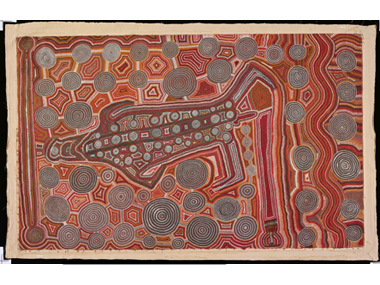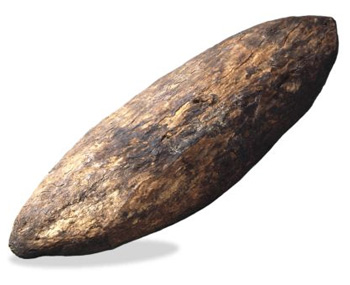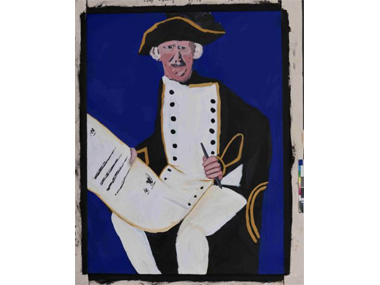MAJOR INDIGENOUS EXHIBITION AT BRITISH MUSEUM

Uta Uta Tjangala's iconic 'Yumari' painting from 1981 - now part of every Aussie passport
Posted by Jeremy Eccles | 29.01.15
Dates:
23.04.15
: 02.08.15
Location: Room 35, British Museum, Fitzrovia, London
The Australian National Museum and the British Museum are joining forces to present one of the most important exhibitions of Indigenous Australian art and artefacts ever staged. 'Enduring Civilisation', as it's called, will open in London in April and transfer to Canberra later this year.
Most of the objects will be sourced from the British Museum. Among them will be a shield collected after a clash at Botany Bay in 1770 between unwelcoming Gweagal people and Captain James Cook's expedition. Gaye Sculthorpe, the British Museum's curator for this show says the shield is a "truly remarkable, significant, important object. There was a skirmish on the beach and this shield was dropped and it was collected and brought back to England."
There is a small hole in the shield believed to have been made by a spear, “symbolic of the first encounters between Europeans and Aboriginal people”.
Objects from such early days of white occupation in Sydney are particularly significant because very few are left after fire destroyed the Australian Museum's collection in Sydney in 1882.
In the lead up to the exhibitions the British Museum has been consulting Aboriginal people about what should go on display. Gaye Sculthorpe believes the exhibition has the potential to contribute to reconciliation between Aboriginal and non-Aboriginal Australians. "And we hope audiences here will be first of all truly astounded to see the beauty and diversity of the objects," she said. "We think it is really important for them to get an understanding of the concept of Country to Indigenous people, and the links between Aboriginal people, objects and Country and how that is portrayed in art, dance, song”.
"We also hope the audiences in London, who are very much an international audience totalling 6 million a year, will also get a better understanding of the history of race relations in Australia - to better understand the issues that are happening in Australia today."
Lissant Bolton, the British Museum's Australian Head for Africa, Oceania and the Americas, also has high hopes for it. "My dream is that it would have a bit of a paradigm shift effect and it would bring people to understand one of the greatest civilisations of the world and certainly the most enduring," she said. She says a joy has been in delving into some of the close friendships between Aboriginal people and British settlers, such as that between Mokare and Alexander Collie in Western Australia.
"That relationship between them was quite a special one, so just to have those glimpses that the remnants of history afford us of people getting on, of people talking, of people exchanging information, of people valuing each other," she said. "It is not the whole story. "There are terrible things that happened; but those things did also happen and it is nice to know about them."
The exhibition also includes the painted masterpiece by Uta Uta Tjangala, 'Yumari', a design which now features on the watermark of current Australian passports – though this has never been officially acknowledged in Australia. There's also a Torres Strait mask collected by the Haddon Expedition in the late 19th Century, a protest placard from the Aboriginal Tent Embassy dated from 1972, more contemporary paintings including specially-commissioned artworks from leading Indigenous artists such as a collaborative work by Spinifex artists.
Many of the objects will travel to Canberra later in 2015 for the related exhibition at the National Museum of Australia. It will be the first time that these have been exhibited in Australia since they were collected. The British Museum hopes that for Aboriginal and Torres Strait Islander peoples this return will be of high cultural and symbolic significance.
The exhibition at the National Museum in Australia, operating under a different name - Encounters - and opening in November, will feature the complex histories of some of the early objects in the British Museum's collection and their continuing significance for Aboriginal and Torres Strait Islander peoples. A fundamental part of the project is re-connecting the objects with the communities from which they originated.
Hopefully, Erub Islanders from the Torres Strait will get the opportunity to see the wacky, turtle-shell mask collected by Joseph Beete Jukes in March 1844 from their island. At the time, Jukes was the naturalist on the British naval ship the HMS Fly which was surveying sea routes through the Torres Strait.
Rare, early Aboriginal and Torres Strait Islander objects like this from the collection of the British Museum will then be displayed alongside contemporary objects, representing the cultural vitality and strength of Aboriginal and Torres Strait Islander culture and heritage in the 21st century. So an 1890s' bicornual basket from the rainforests will sit beside an Abe Muriata version from 2012. Other contemporary Indigenous artists such as Julie Gough, dancer Elma Kris, Judy Watson and Jonathan Jones have visited the collection in London in order to create works that respond to the histories of these collections.
URL: http://www.britishmuseum.org/indigenousaustralia http://www.nma.gov.au/exhibitions/encounters
Share this:
»  del.icio.us
»
del.icio.us
»  Digg it
»
Digg it
»  reddit
»
reddit
»  Google
»
Google
»  StumbleUpon
»
StumbleUpon
»  Technorati
»
Technorati
»  Facebook
Facebook
Contact Details

The shield brought home from Botany Bay by Captain Cook in 1770

'James Cook - with the Declaration', by Albert's grandson, Vincent Namatjira, 2014
Further Research
Artists: Abe Muriata | Jonathan Jones | Julie Gough,Judy Watson | Uta Uta Tjangala | Vincent Namatjira
News Tags: Aboriginal artefacts | British Museum | Enduring Civilisation | Gaye Sculthorpe | Jeremy Eccles | National Museum | NMA
News Categories: Australia | Blog | Europe | Exhibition | Feature | Industry | News
Exhibition Archive
- 10.10.17 | TARNANTHI 2017
- 11.08.17 | Natsiaas 2017
- 20.07.17 | APY ART DOMINATES THE WYNNE
- 17.07.17 | Anangu Artist Wins $100,000 Prize
- 14.07.17 | The End of AAMU
- 11.07.17 | ART ACROSS THE COUNTRY
- 11.07.17 | TARNANTHI IN OCTOBER
- 05.07.17 | TJUNGUṈUTJA - from having come together
- 13.06.17 | Ghost-Nets Straddle the World
- 07.06.17 | Grayson Perry Going Indigenous?
- 05.06.17 | Barks Bigger than Ben Hur
- 27.05.17 | NGA QUINQUENNIAL 2017
- 21.05.17 | Blak Douglas Finds Home at the NGA
- 21.05.17 | BRIAN ROBINSON WINS HAZELHURST WOP
- 18.05.17 | PARRTJIMA 2.0
Advertising

